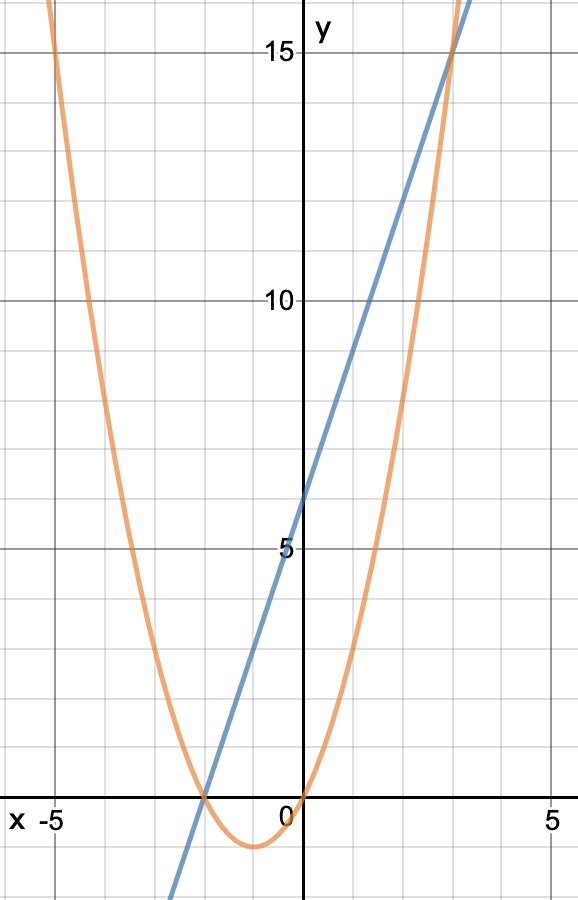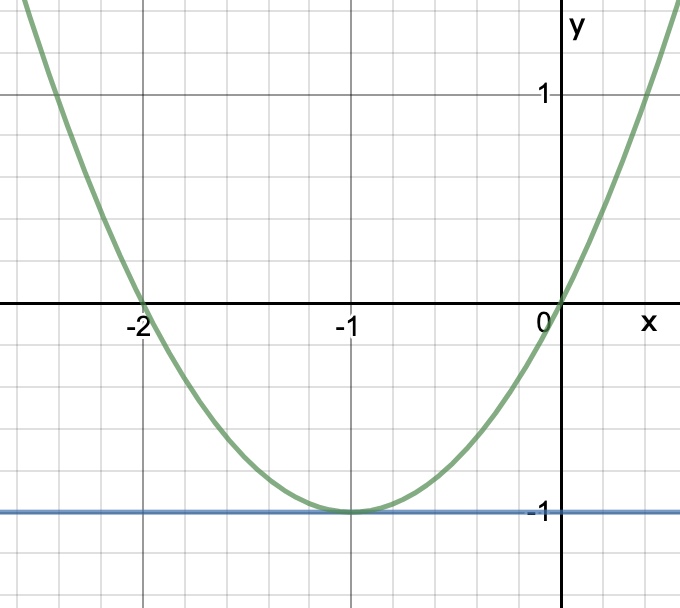 An example of graphed simultaneous equations, transom.org
An example of graphed simultaneous equations, transom.org
The above graph shows the simultaneous equations
1)
2)
There is one solution that satisfies both equations and you can see it at the point where the two lines cross. This is actually one way to solve simultaneous equations, but we will show you better and faster ways in this guide, so read on!
Check out our guide to Solving Linear Equations if you need a refresher on solving for one unknown, as we will be building on this.
Why do we need simultaneous equations?
If you want to solve an equation with only one unknown value, the process is usually very straightforward. However, things become more complex when additional unknowns are introduced. Consider the first equation from before:
You can try out different numbers and see that one potential solution would be . But there are actually infinite solutions. Think about what would happen if x or y were Fractions!
We need a second equation to identify a single, unique solution.
How do you solve simultaneous equations?
You can solve simultaneous equations in a few different ways. We will show you the two best ways, as they are faster than using a graph as shown before. Each way can be easier depending on the question, and you may find one comes more naturally to you, so be sure to try them both.
Solving by elimination
One way to solve simultaneous equations is by elimination. You can use this method most easily when the unknown you want to eliminate has the same coefficient in each equation, but we'll show you how to use it in other cases too.
Let's go back to our original equations:
We can see that if we add each side of the two equations together, we'll be able to easily eliminate y. (You can add or subtract the equations depending on the situation.) Let's try it!
This leaves us with the single equation:
Now we can substitute this into one of the original equations to find y:
Finally, it's important to always check your work by substituting these values into the other equation. This is crucial to help you spot mistakes you may have made.
Solve
To begin with you can subtract each side of the one equation from one another in order to eliminate the x;
Now you can work with the answers to form a new equation to solve for y;
This answer can now be substituted into one of the original equations to solve for x;
Finally, don't forget to check your answers by substituting them into one of the equations;
Solving by elimination (different coefficients)
Let's take a look at a new example now:
1)
2)
In this example using elimination isn't as straightforward as before. We need to change the equations in some way to make the coefficients the same. We're allowed to do this as long as we perform the same operation on both sides of the equation.
It looks like we can get the same coefficient of y by multiplying the first equation by 3 and the second by 2. Let's try that:
1)
2)
Now we can subtract them to eliminate y, then substitute in our answer for x as before:
check:
Solve
To do this you first need to make two of the coefficients the same, to do this we can multiply the first equation by 2, which gives us these equations;
Now you can subtract one equation from the other to eliminate y and solve for x;
Now you can input your x into one of the equations to solve for y;
Don't forget it is possible to check your answers by substituting both answers into the equation and checking that it works;
Solving by substitution
There is another way we could have approached the first set of equations: substitution. Recall that in our previous examples, once we have found one value we can substitute it back into the equation to find the other. This method involves the same technique, but at a different point in the process.
1)
2)
To use the substitution method you can begin by substituting equation 2 into the y of equation 1 to help you find x;
You can now substitute 4 into one of the equations to find y;
1)
2)
In this case we need to rearrange equation 2 in order to get it in terms of y, doing this will allow us to substitute it into equation 1 and solve for x;
3)
4)
The last step remains the same: we just use this value in the second equation, which gives us y = 1 as before. Then make sure to check your answer!
How do you solve simultaneous equations with a quadratic?
To solve simultaneous equations with a quadratic, we build on the substitution method from before. 1)
2)
On a graph, these equations would look like this:

Worked example, transom.org
The first thing we need to do in this case is rearrange the first equation. The key is to make them both equal y, (ie equal to the same thing), because that means we can make them both equal to each other.
3)
Now we have a quadratic equation that you can solve using your preferred method. In this example we're going to use factorization . (If you need some practice with this, check out our article on Factoring Quadratic Expressions!)
As you can see, we have two possible values for x. This means we need to substitute them each back in to find two pairs of solutions for our simultaneous equations:
1) or 1)
This gives us the pairs
or
check:
2)
In this example, we had two solutions, but it's important to remember there doesn't have to be two. There could be one or even none, just like when you solve a quadratic equation on its own. For example, think about how many solutions would be in the graph shown below:

Example graph showing multiple solutions, transom.org
How do you form your own simultaneous equations?
To form your own simultaneous equations, you may need to interpret a body of text. Some questions are wordier and take a bit of thought to construct the equations before solving them.
Ali buys 2 toffees and 3 gumballs. Bea buys 3 toffees and 2 gumballs. Ali's total comes to £0.10 and Bea pays £0.15. How much are toffees and gumballs?
First, we need to identify the variables. In this case they are toffees and gumballs. We can see that 2 toffees and 3 gumballs cost 10p, and 3 toffees and 2 gumballs cost 15p. Using this information we can write the following equations, where g represents the gumballs and t represents the toffees:
1)
2)
You can see these are actually one of the sets of simultaneous equations from before!
Simultaneous Equations - Key takeaways
Simultaneous equations allow us to find unique solutions .
The graphical method involves drawing each equation on a graph and the solution is the point where the lines cross.
The elimination method involves eliminating one unknown by adding or subtracting the equations, then solving for the remaining unknown.
The substitution method involves rearranging one equation to be in terms of one unknown, then substituting it into the other to solve for the remaining unknown.
- You can solve quadratic simultaneous equations by rearranging the linear equation and making it equal to the quadratic one in order to construct a quadratic equation and solve it using your preferred method. Remember there are often multiple solutions.










